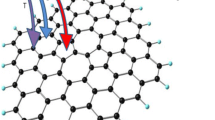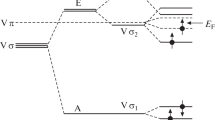Abstract
In this paper, we study the electronic and band structure of 4p-elements (M = Ge, Si)-doped graphene nanosheets with vacancies by the density functional theory method. The adsorption energy of the doping atoms and the relative stability of doped graphene monolayers are estimated. An antiferromagnetic ordering is discovered in these graphene-based systems. Based on the analysis of the electronic populations of atomic orbitals according to Mulliken, the states’ densities in graphene systems are calculated. The equilibrium parameters of the electronic structure of graphene nanosheets are obtained. The regularities of changes in the electronic structure of the valence band and the induction of an energy gap in M-doped graphene monolayers containing vacancies are studied. The features of the electronic structure near the Fermi level, as well as the role of the structural effect in opening the energy gap in graphene–M systems, are discussed. Doping with 4p elements opens the energy gap in graphene–Ge(Si) systems. The local magnetic moments for antiferromagnetic ordering are estimated on carbon atoms of graphene nanosheets including Ge(Si). The calculated values of the local magnetic moments on carbon atoms in graphene–M (Ge, Si) systems are comparable with each other.




Similar content being viewed by others
REFERENCES
Asadov, S.M., Mustafaeva, S.N., and Lukichev, V.F., Charge transport in layer gallium monosulfide in direct and alternate electric fields, Russ. Microelectron., 2019, vol. 48, no. 6, pp. 422–427. https://doi.org/10.1134/S1063739719660016
Asadov, S.M., Mustafaeva, S.N., Lukichev, V.F., and Guseinov, D.T., Effect of the composition on the dielectric properties and charge transfer in 2D GaS1–xSex materials, Russ. Microelectron., 2019, vol. 48, no. 4, pp. 203–207. https://doi.org/10.1134/S1063739719040024
Mustafaeva, S.N., Asadov, M.M., and Ismailov, A.A., Dielectric and baric characteristics of TlS single crystal, Phys. B (Amsterdam, Neth.), 2014, vol. 453, pp. 158–160. https://doi.org/10.1016/j.physb.2014.03.095
Lukichev, V.F. and Amirov, I.I., Research and development in the field of micro and nanosystems, Istor. Nauki Tekh., 2018, no. 8, pp. 92–99.
Ng, L.W.T., Hu, G., Howe, R.C.T., Zhu, X., Yang, Z., Jones, C.G., and Hasan, T., Printing of Graphene and Related 2D Materials, Switzerland: Springer, 2019. https://doi.org/10.1007/978-3-319-91572-2
Gupta, T., Graphene. Carbon, Switzerland: Springer Int., 2018, pp. 197–228. https://doi.org/10.1007/978-3-319-66405-7_7
Radamson H.H., Graphene, in Springer Handbook of Electronic and Photonic Materials, Kasap, S. and Capper, P., Eds., Cham: Springer, 2017, pp. 1173–1183. https://doi.org/10.1007/978-3-319-48933-9_48.
Wolf, E.L., Applications of Graphene, New York: Springer Science, 2014. https://doi.org/10.1007/978-3-319-03946-6
Kühne, M., Lithium Intercalation in Bilayer Graphene Devices, Switzerland: Springer Nature AG, 2018. https://doi.org/10.1007/978-3-030-02366-9
Frontiers of Graphene and Carbon Nanotubes, Matsumoto, K., Ed., Japan: Springer, 2015. https://doi.org/10.1007/978-4-431-55372-4
Tetlow, H.A., Theoretical Modeling of Epitaxial Graphene Growth on the Ir(111) Surface, Cham: Springer, 2017. https://doi.org/10.1007/978-3-319-65972-5
Brownson, D.A.C. and Banks, C.E., The Handbook of Graphene Electrochemistry, London: Springer, 2014. https://doi.org/10.1007/978-1-4471-6428-9
Liu, X., Nanomechanics of Graphene and Design of Graphene Composites, Singapore: Springer Nature, 2019. https://doi.org/10.1007/978-981-13-8703-6
Van Tuan, D., Charge and Spin Transport in Disordered Graphene-Based Materials, Switzerland: Springer Int., 2016. https://doi.org/10.1007/978-3-319-25571-2
Ruitao, L. and Terrones, M., Towards new graphene materials: doped graphene sheets and nanoribbons, Mater. Lett., 2012, vol. 78, pp. 209–218. https://doi.org/10.1016/j.matlet.2012.04.033
Arsent’ev, M.Yu., Prikhodko, A.V., Shmigel, A.V., Egorova, T.L., and Kalinina, M.V., Doping graphene with a monovacancy: bonding and magnetism, J. Phys.: Conf. Ser., 2015, vol. 661, p. 012028. https://doi.org/10.1088/1742-6596/661/1/012028
Loghavi, M.M., Mohammadi-Manesh, H., Eqra, R., Ghasemi, A., and Babaiee, M., DFT study of adsorption of lithium on Si, Ge-doped divacancy defected graphene as anode material of Li-ion battery, Phys. Chem. Res., 2018, vol. 6, no. 4, pp. 871–878. https://doi.org/10.22036/pcr.2018.148943.1543
Habenicht, B.F., Teng, D., Semidey-Flecha, L., Sholl, D.S., and Xu, Y., Adsorption and diffusion of 4d and 5d transition metal adatoms on graphene/Ru(0001) and the implications for cluster nucleation, Top. Catal., 2014, vol. 57, pp. 69–79. https://doi.org/10.1007/s11244-013-0163-6
Guan, Z., Ni, S., and Hu, S., First-principles study of 3d transition-metal-atom adsorption onto graphene embedded with the extended line defect, ACS Omega, 2020, vol. 1. https://doi.org/10.1021/acsomega.9b04154
Acun, A., Zhang, L., Bampoulis, P., Farmanbar, M., Houselt, A., Rudenko, A.N., Lingenfelder, M., Brocks, G., Poelsema, B., Katsnelson, M.I., and Zandvliet, H.J.W., Germanene: The germanium analogue of graphene, J. Phys.: Condens. Matter, 2015, vol. 27, no. 11, p. 443002. https://doi.org/10.1088/0953-8984/27/44/443002
Aktürk, E., Ataca, C., and Ciraci, S., Effects of silicon and germanium adsorbed on graphene, Appl. Phys. Lett., 2010, vol. 96, p. 123112.https://doi.org/10.1063/1.3368704
Ren, J.G., Wu, Q.H., Tang, H., Hong, G., Zhang, W., and Lee, S.T., Germanium-graphene composite anode for high-energy lithium batteries with long cycle life, J. Mater. Chem. A, 2013, vol. 1, p. 1821. https://doi.org/10.1039/C2TA01286C
Tripathi, M., Markevich, A., Böttger, R., Facsko, S., Besley, E., Kotakoski, J., and Susi, T., Implanting germanium into graphene, ACS Nano, 2018, vol. 12, p. 4641. https://doi.org/10.1021/acsnano.8b01191
Denis, P.A., Chemical reactivity and band-gap opening of graphene doped with gallium, germanium, arsenic, and selenium atoms, Chem. Phys. Chem., 2014, pp. 1–8. https://doi.org/10.1002/cphc.201402608
Denis, P.A., Band gap opening of monolayer and bilayer graphene doped with aluminium, silicon, phosphorus, and sulfur, Chem. Phys. Lett., 2010, vol. 492, pp. 251–257. https://doi.org/10.1016/j.cplett.2010.04.038
Yengejeh, S.I., Kazemi, S.A., and Öchsner, A.A., Primer on the Geometry of Carbon Nanotubes and Their Modifications, Switzerland: Springer Int., 2015. https://doi.org/10.1007/978-3-319-14986-8_1
Kohn, W. and Sham, L.J., Self-consistent equations including exchange and correlation effects, Phys. Rev. A, 1965, vol. 140, no. 4, p. 1133A–1138A. https://doi.org/10.1103/PhysRev.140.A1133
Kohn, W., Nobel lecture: Electronic structure of matter-wave functions and density functionals, Rev. Mod. Phys., 1999, vol. 71, no. 5, pp. 1253–1266. https://doi.org/10.1103/RevModPhys.71.1253
Evarestov, R.A., Quantum Chemistry of Solids, Berlin, Heidelberg: Springer, 2012. https://doi.org/10.1007/978-3-642-30356-2
Tsuneda, T., Density Functional Theory in Quantum Chemistry, Japan: Springer, 2014. https://doi.org/10.1007/978-4-431-54825-6
Ernzerhofa, M. and Scuseria, G.E., Assessment of the Perdew-Burke-Ernzerhof exchange-correlation functional, J. Chem. Phys., 1999, vol. 110, no. 11, pp. 5029–5036.
Tolba, S.A., Gameel, K.M., Ali, B.A., Almossalami, H.A., and Allam, N.K., The DFT + U: Approaches, Accuracy and Applications, Rijeka: InTech Open, 2018.
Mulliken, R.S., Electronic population analysis on LCAOMO molecular wave functions, J. Chem. Phys., 1955, vol. 23, p. 1833. https://doi.org/10.1063/1.1740588
Bader, R.F.W., Atoms in Molecules. A Quantum Theory, Oxford: Clarendon, 1994.
Tang, W., Sanville, E., and Henkelman, G., A grid-based Bader analysis algorithm without lattice bias, J. Phys.: Condens. Matter, 2009, vol. 21, p. 084204. https://doi.org/10.1088/0953-8984/21/8/084204
Stefanov, B.B. and Cioslowski, J., An efficient approach to calculation of zero-flux atomic surfaces and generation of atomic integration data, J. Comput. Chem., 1995, pp. 1394–1404. https://doi.org/10.1002/jcc.540161108
Khanna, S.N. and Castleman, A.W., Quantum Phenomena in Clusters and Nanostructures, Berlin, Heidelberg: Springer, 2003. https://doi.org/10.1007/978-3-662-02606-9
Guimarães, A.P., Principles of Nanomagnetism, 2nd ed., Switzerland: Springer Int., 2017. https://doi.org/10.1007/978-3-319-59409-5
Author information
Authors and Affiliations
Corresponding authors
Ethics declarations
FUNDING
This work was supported by the Science Development Foundation under the president of the Republic of Azerbaijan, project no. EİF-BGM-3-BRFTF-2+/2017-15/05/1-M-13 and the Russian Foundation for Basic Research, project no. 18-57-06001 Az_a 2018.
CONFLICT OF INTEREST
The authors declare that they have no conflict of interest.
Additional information
Translated by A. Ivanov
Rights and permissions
About this article
Cite this article
Asadov, M.M., Guseinova, S.S. & Lukichev, V.F. Ab Initio Modeling of the Electronic and Energy Structure and Opening the Band Gap of a 4p-Element-Doped Graphene Monolayer. Russ Microelectron 49, 314–323 (2020). https://doi.org/10.1134/S1063739720050030
Received:
Revised:
Accepted:
Published:
Issue Date:
DOI: https://doi.org/10.1134/S1063739720050030




